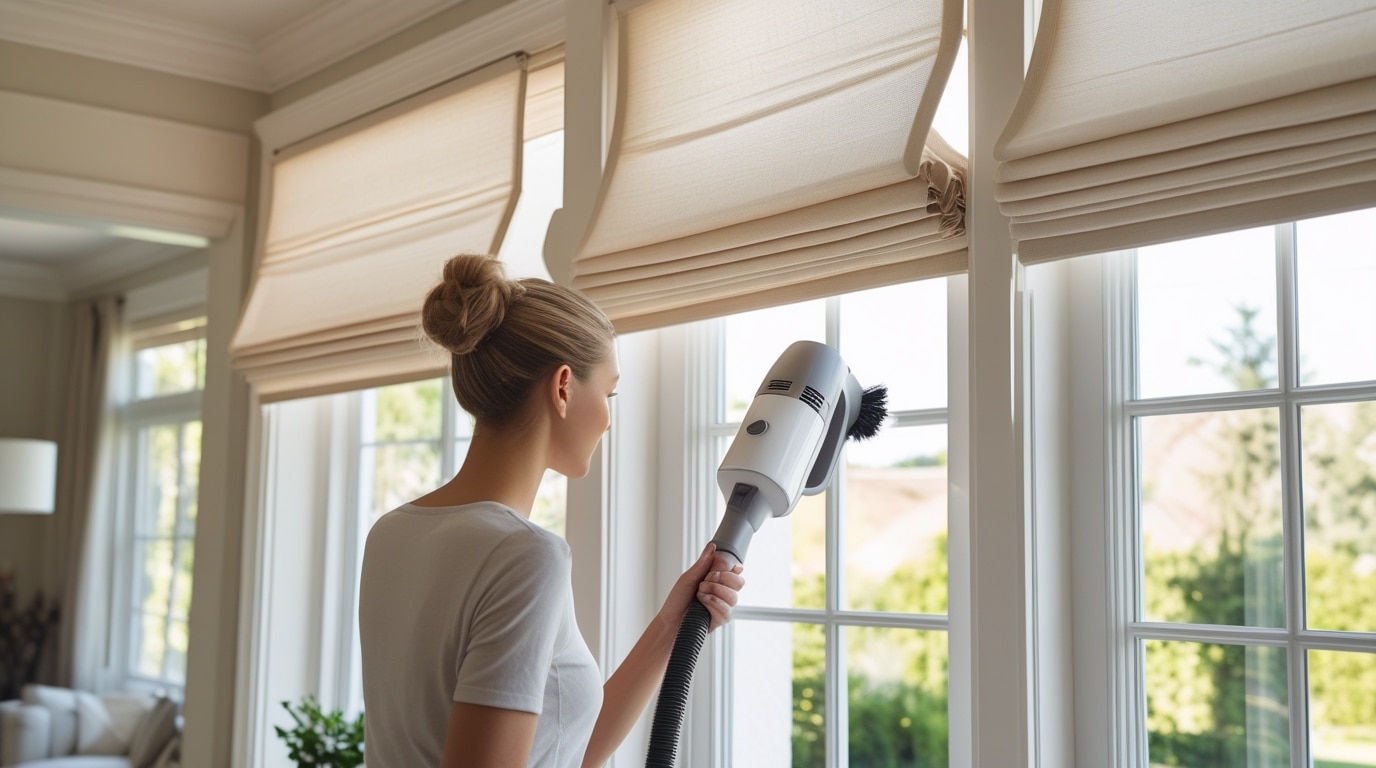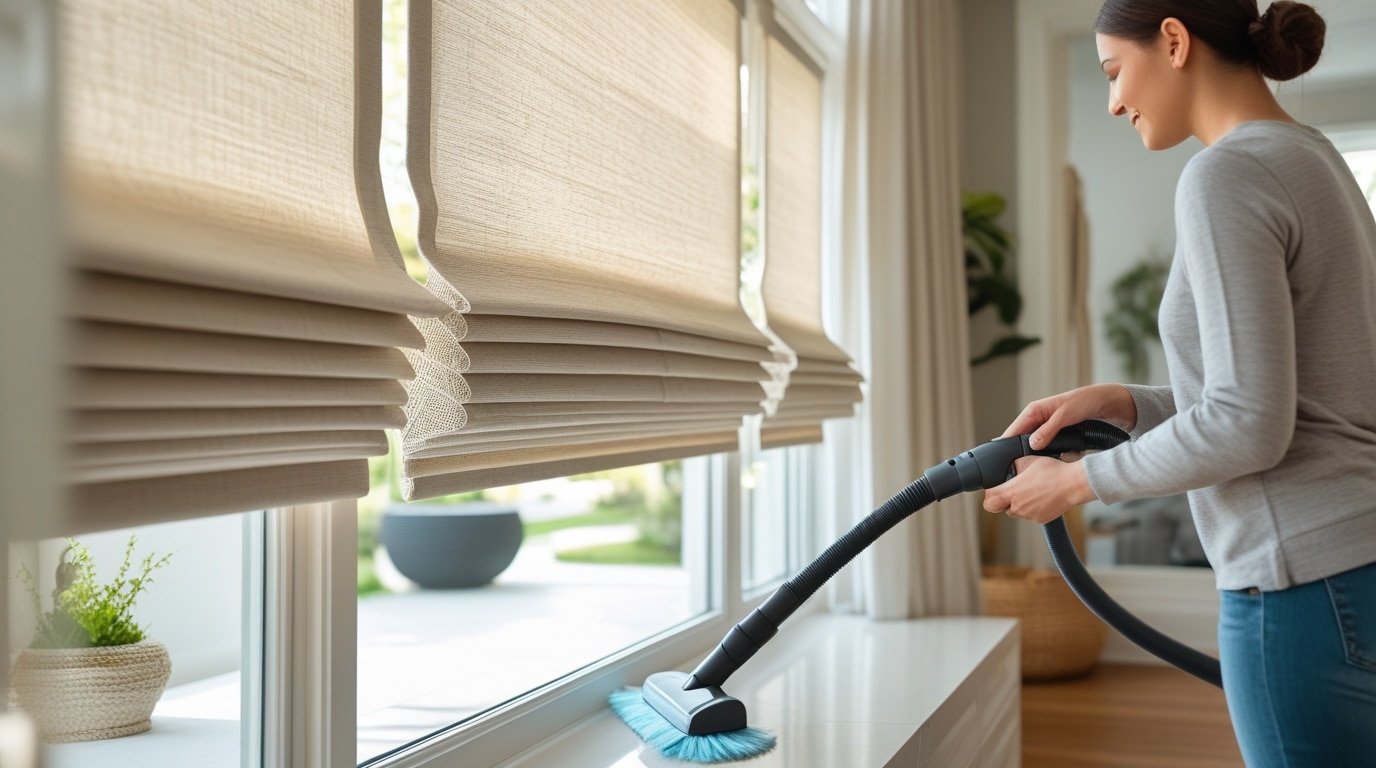Introduction: Why Cleaning Roman Shades is Essential
Roman shades are a stylish and functional window treatment that adds elegance to any home. However, like all fabric-based coverings, they tend to accumulate dust, allergens, and stains over time. Proper maintenance and cleaning not only keep them looking pristine but also prolong their lifespan. Many homeowners overlook the importance of regular shade cleaning, assuming that since they don’t touch them often, they remain clean. In reality, airborne particles, pet dander, and moisture can settle into the fabric, making them a hidden source of dirt and allergens.
Cleaning Roman shades is not just about aesthetics; it’s also about maintaining a healthy indoor environment. Dirty shades can trap dust, contributing to poor air quality and potential respiratory issues. If shades are neglected, built-up grime can lead to permanent discoloration, reducing their overall visual appeal.
Different types of Roman shades require different cleaning techniques. Whether your shades are made of delicate silk, cotton, linen, or synthetic blends, each material demands a tailored approach to ensure effective cleaning without causing damage. Additionally, certain styles, such as cascading folds or flat panel designs, require special care to maintain their structure.
In this guide, we will explore effective methods to clean Roman shades, from basic dusting and spot-cleaning techniques to deeper cleaning solutions. You will learn how to clean fabric shades without fading their color, how to remove stubborn stains, and how to keep your shades looking fresh with minimal effort.
How to Clean Roman Shades: Understanding the Basics (Point-Wise)
- Roman Shades vs. Other Window Treatments
- Unlike blinds with hard surfaces, Roman shades are made of fabric that absorbs dust, moisture, and odors.
- This makes them more susceptible to stains and discoloration.
- Shades with intricate folds trap more dust compared to flat designs, requiring thorough cleaning.
- Routine Dusting for Maintenance
- Regular dusting prevents dirt from embedding into the fabric.
- Use a vacuum with a brush attachment to remove loose dust weekly.
- For lighter maintenance, a feather duster or microfiber cloth can be used.
- If dust accumulates over time, deep cleaning may be necessary to restore brightness.
- Spot Cleaning for Stains and Spills
- Use mild detergent diluted in water and a soft cloth to dab at stains.
- Avoid rubbing, as it can spread the stain and damage fabric fibers.
- Always test the cleaning solution on a small, hidden area before applying it to the entire shade.
- Deep Cleaning Options for Roman Shades
- Dry cleaning is recommended for delicate materials like silk and wool, as they should not be exposed to water.
- Machine washing is possible for some cotton or polyester blends only if the manufacturer’s label permits.
- Proper handling is crucial to preserving the shape and structure of the shades.
By following these cleaning techniques, you can ensure that your Roman shades remain fresh, clean, and well-maintained for years to come.
How Do You Clean Roman Shades Without Damaging Them?
Cleaning Roman shades requires a delicate touch, especially for high-end or custom-made window treatments. While regular maintenance helps prevent major dirt buildup, sometimes deeper cleaning is necessary. However, the wrong cleaning method can lead to fraying, shrinkage, or color fading. Understanding the safest way to clean your shades while maintaining their original quality is key.
One of the most common mistakes people make when cleaning Roman shades is using too much water. Excess moisture can weaken the fabric and lead to warping. Instead, lightly dampening a cloth with a gentle cleaning solution is the safest approach. Using a dry microfiber cloth after spot cleaning helps remove any excess moisture and speeds up the drying process.
For stubborn stains, a fabric-safe stain remover can be used. It’s important to blot the stain rather than scrub it, as scrubbing can distort the weave of the fabric. If the stain persists, repeating the spot-cleaning process with a fresh cloth and mild detergent can gradually lift it without causing damage.
Another factor to consider is exposure to sunlight. While cleaning, it’s best to do so in a shaded area rather than in direct sunlight. Harsh sunlight can cause the fabric to fade, especially if the shades are wet. To further protect against fading, using UV-blocking window films or sheer curtains in addition to Roman shades can help maintain their color over time.
Roman Shade Cleaning Tips: Quick & Easy Methods
✔ Regular maintenance is key – Light cleaning helps prevent dust accumulation and keeps Roman shades looking fresh.
✔ Use a handheld vacuum with a soft brush attachment – Running the vacuum over the shades once a week prevents dirt from settling deep into the fibers.
✔ Try compressed air for delicate fabrics – A can of compressed air helps remove dust from hard-to-reach areas, especially for shades with intricate folds or decorative trimmings.
✔ Use fabric refresh sprays to eliminate odors – A light misting of a fabric-safe deodorizer helps remove cooking smells, pet odors, and dust without soaking the fabric.
✔ Remove pet hair with a lint roller or rubber glove – Gently rolling a lint roller over the surface keeps the shades neat. Alternatively, rubbing the fabric with a rubber glove creates static that lifts pet hair.
By incorporating these quick and easy cleaning methods, you can ensure that your Roman shades remain clean, fresh, and well-maintained for a long time.
How to Clean Fabric Window Shades & Cloth Shades

Fabric window shades require extra care to ensure that the fibers remain intact. Different types of fabric react differently to cleaning methods, so it’s important to identify the material before proceeding. Cotton and linen shades are generally more durable and can handle light washing, while silk and velvet require specialized cleaning to prevent damage.
When dealing with water-safe fabrics, using a mild detergent diluted in warm water is the best approach. A soft cloth or sponge can be dipped into the solution and gently dabbed onto the fabric to lift stains. After cleaning, using a clean, damp cloth to remove soap residue ensures that the fabric does not develop water spots.
For deep cleaning, steam cleaning is a good alternative to machine washing. A fabric steam cleaner gently removes dirt without excessive moisture, making it an ideal choice for delicate materials. The heat from the steam also kills dust mites, which can be beneficial for those with allergies.
Maintaining fabric shades also involves proper drying. Allowing them to air dry completely before raising them prevents mold growth. If necessary, a hairdryer on a low, cool setting can speed up the drying process.
Conclusion: Maintaining Clean Roman Shades for Longevity
Keeping Roman shades clean does not have to be a challenging task. By following the right techniques and incorporating regular maintenance, homeowners can ensure their window treatments remain in excellent condition for years. Light cleaning methods such as vacuuming, dusting, and spot-cleaning can prevent the buildup of dirt and allergens, while deep cleaning should be done only when necessary to avoid excessive wear.
Choosing the right cleaning method depends on the fabric type and level of dirt accumulation. Understanding how to clean different materials helps prevent damage and preserves the original appearance of the shades. With the right approach, maintaining Roman shades becomes a simple yet effective way to enhance both the aesthetics and hygiene of a home.



